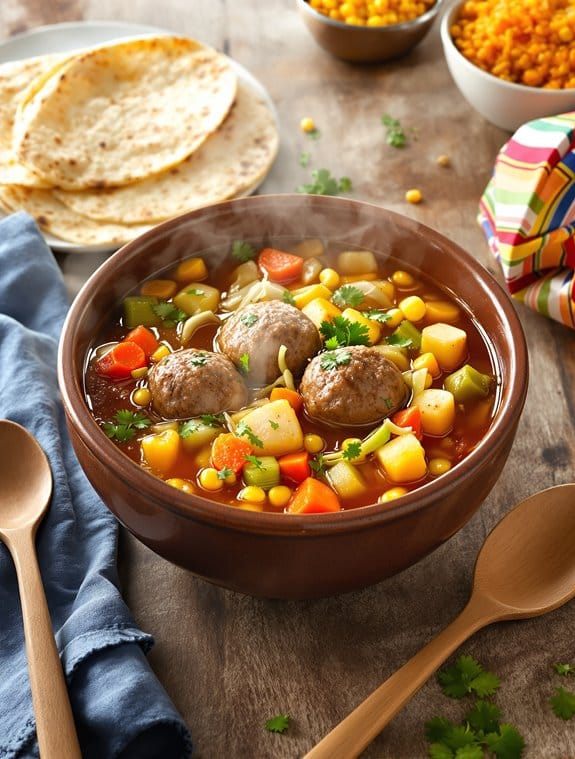Why You’ll Love these Hearty Albondigas
Tradition in a soup pot—that’s what these albondigas represent. When I make this hearty Mexican meatball soup, I’m instantly transported to my grandmother’s kitchen, where the aroma of simmering broth and cilantro filled every corner.
You’ll love how the corn flakes (yes, really) make these meatballs incredibly fluffy—a secret trick passed down through generations. The combination of tender beef, rice, and vegetables creates a meal that satisfies completely on chilly evenings.
The beauty lies in its simplicity. Fresh vegetables, savory broth, and perfectly seasoned meatballs come together in a dance of flavors that feels like a warm hug from someone who loves you.
What Ingredients are in Hearty Albondigas?
To make our Abuela’s Hearty Albondigas Soup, you’ll need a thoughtful combination of ingredients that create those tender, fluffy meatballs swimming in a vegetable-packed broth.
This traditional Mexican soup relies on fresh produce and a surprising secret ingredient that makes all the difference in the texture of the meatballs. The recipe might look long, but don’t worry—most items are probably already in your pantry or can be easily found at any grocery store.
- 1½ pounds lean ground beef
- 4 beef bouillon cubes
- 6 medium potatoes, cubed
- 6 carrots, chopped
- 1 whole onion, chopped
- 4 zucchini, chopped
- 5 stalks celery, chopped
- ½ head cabbage, chopped
- 3 ears corn, halved
- ¼ cup cooked rice
- 1 bunch fresh cilantro, chopped
- 1 egg
- 1 cup corn flakes
- Salt and pepper to taste
- Stewed tomatoes (amount not specified in the original recipe)
- Water for the broth
The corn flakes might seem unusual in a meatball recipe, but trust me, they’re the secret weapon that makes these albondigas incredibly light and fluffy.
You could substitute breadcrumbs in a pinch, but you’d miss out on that special texture that makes these meatballs memorable. When shopping for this recipe, try to select fresh vegetables that are firm and brightly colored—the quality of your produce will directly impact the flavor of your finished soup.
And don’t skip the fresh cilantro; its bright, herbaceous notes are what gives this soup its distinctive Mexican character.
How to Make these Hearty Albondigas

Start by filling a large Dutch oven a little over half full with water, then add 4 beef bouillon cubes to create your flavorful broth base. While the water begins to heat, prep your vegetables: 6 medium potatoes (cubed), 6 carrots (chopped), 1 whole onion (chopped), 5 stalks of celery (chopped), and 3 ears of corn (halved).
Add these vegetables along with the stewed tomatoes to the pot and bring everything to a boil. Notice how I’m leaving out the zucchini and cabbage? That’s intentional—we’ll add those later so they don’t overcook and turn mushy.
Now for the star of the show: those magnificent meatballs. In a large mixing bowl, combine 1½ pounds of lean ground beef, ¼ cup of cooked rice, 1 cup of corn flakes (yes, really!), 1 bunch of chopped fresh cilantro, and 1 egg.
Mix these ingredients thoroughly with your hands—there’s really no better tool for the job—and then form the mixture into balls about the size of a golf ball. Once your broth is boiling, gently drop the meatballs in one by one.
Let them cook for about 25 minutes, during which they’ll become incredibly tender and infuse the broth with rich flavor. During the final 5 minutes of cooking, add the 4 chopped zucchini and ½ head of chopped cabbage, then season with salt and pepper to taste.
The soup is traditionally served with Mexican rice on the side and warm corn tortillas for dipping. What makes these albondigas uniquely tender is that surprising ingredient—corn flakes! They might seem out of place in a traditional Mexican recipe, but they create an unbelievably light texture that breadcrumbs just can’t match.
When you ladle this soup into bowls, make sure everyone gets at least one or two meatballs and plenty of the vegetable-rich broth. The vibrant colors and hearty ingredients make this not just a meal, but a feast for all the senses.
Hearty Albondigas Substitutions and Variations
While my abuela’s recipe is a cherished family treasure, I’ve learned over the years that albondigas soup welcomes creative adaptations that can suit any dietary need or pantry situation. Ground turkey or chicken makes a leaner meatball, and quinoa can replace rice for extra protein.
No corn flakes? Try breadcrumbs or crushed crackers instead.
For veggie swaps, sweet potatoes offer a lovely contrast to the savory broth. Can’t find fresh corn? Frozen works perfectly.
Some relatives add a dash of cumin or oregano to the meatballs—a little rebellion that even abuela eventually came to appreciate. The soul of albondigas lies in its adaptability.
What to Serve with Hearty Albondigas
When my abuela served her famous albondigas soup, she always insisted it wasn’t just a meal but an experience that required proper accompaniments.
I’ve learned to pair it with warm corn tortillas—slightly charred on the flame, folded and ready for dipping into that rich broth. Mexican rice is non-negotiable; the fluffy grains soaking up those savory soup juices? Pure heaven.
Sometimes I’ll add a simple side salad with lime dressing or sliced avocado with a sprinkle of salt.
And don’t forget lime wedges and chopped cilantro at the table. Your guests will thank you.
Final Thoughts
After simmering pots of this albondigas soup for decades, I’ve come to appreciate how food connects generations more than almost anything else.
My grandmother’s secret corn flake trick for fluffy meatballs still brings smiles around my dinner table, just as it did when I was small.
I hope this recipe finds its way into your family’s rotation.
There’s something magical about watching someone you love slurp that first spoonful, eyes closing in appreciation.
The humble ingredients transform into something greater than their parts, much like families themselves.

Abuela’s Hearty Albondigas Soup
Ingredients
Equipment
Method
- Fill a large Dutch oven slightly more than half full with water and add the beef bouillon cubes to create your broth base.
- Prepare your vegetables by cubing the potatoes, chopping the carrots, onion, and celery, and halving the corn ears.
- Add the prepared potatoes, carrots, onion, celery, corn, and stewed tomatoes to the pot. Bring everything to a boil.
- While the broth is heating, prepare the meatballs. In a large mixing bowl, combine the ground beef, cooked rice, corn flakes, chopped cilantro, and egg.
- Mix the meatball ingredients thoroughly with your hands until well combined.
- Form the mixture into golf ball-sized meatballs.
- Once the broth is boiling, carefully drop the meatballs into the pot one by one.
- Allow the meatballs to cook in the simmering broth for about 25 minutes, during which they’ll become tender and flavor the soup.
- During the final 5 minutes of cooking, add the chopped zucchini and cabbage to the pot.
- Season the soup with salt and pepper to taste.
- Serve hot, ensuring each bowl contains at least one or two meatballs and plenty of vegetables and broth.



